
How A New Orleans Home Repair Program Helps Save the City's Historic Fabric
From the steps of Darlene Joseph Jones’s home, the culture of New Orleans can be found everywhere one looks and listens.
Jones, 70, lives in the Tremé neighborhood, believed to be the oldest historically Black community in the United States. In a longtime local Black tradition, tribes of Black Masking Indians (also known as Mardi Gras Indians) still wander the streets several times each year, showing off suits elaborately decorated with tens of thousands of colorful feathers and beads. On Sundays, generations of New Orleanians flock to the neighborhood for its second line parades, dancing in the streets to the overwhelming wall of sound coming from a brass band belting out classics under a raised highway.
But to longtime residents, it is obvious that Tremé is changing. While many of the city’s best-known jazz musicians grew up here and still can be heard performing in neighborhood music clubs, gentrification and the proliferation of short-term rentals have drastically reduced the number of those clubs. Most urgently, these same forces are pushing many Black homeowners—families who have lived in the neighborhood for decades—to sell their houses and move elsewhere.
“People think it’s the food, music, and architecture that make New Orleans culture special,” says Jones, who bought her house in 2007, just two years after Hurricane Katrina devastated the city. “But they’re only partially right. What’s really important are the people. Who cooks the food? Who plays the music? Who has lived in these homes for generations?
“Our people are what make New Orleans special, but many of us can’t afford to live here anymore.”
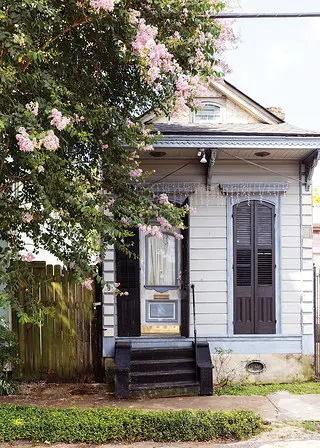
photo by: Cedric Angeles
Darlene Jones’s house, with its repaired roof and other improvements.

photo by: Cedric Angeles
Jones in her front yard.
Jones lives in a shotgun house. So do most of her neighbors. The famously colorful dwellings dominate historic New Orleans communities, painted in blues, yellows, purples, and oranges. Inside, four or five rooms are arranged in a straight line, one behind the other and without a hallway. This layout provides airflow to combat the city’s infamous humidity, as well as a solution to its long, narrow plots of land.
Shotgun houses have been popular in New Orleans since the early 19th century, when a population boom owing to an influx of refugees from the Haitian Revolution resulted in a need for affordable housing. Jones’s home was likely built around 1900, and she purchased it more than 100 years later.
She was residing in senior housing when Katrina struck, leaving 80% of New Orleans underwater. In the days that followed, Jones, who has nerve damage in one of her arms, helped with the medical evacuation of her most vulnerable neighbors. She lived in an abandoned city and an apartment with no electricity for a week until she was finally evacuated.
Stay connected with us via email. Sign up today.
Jones lived in Chicago for a year before her desire to come home grew too strong to ignore. She spent her next year in a FEMA trailer parked on her father’s front lawn before piecing together the money to buy her Tremé house.
“It felt important to own a home then,” she remembers. “The future of New Orleans neighborhoods [was] being decided in the years after Katrina, and it was being decided, in part, by the homeowners paying property taxes in those neighborhoods. I wanted to stand up for my city.”
The house was a dream—the only one Jones viewed. But slowly, almost imperceptibly, her dream home became a nightmare.
“I noticed a crack in the wall in my bedroom,” she says. “At first it was small, but over the years it grew to more than 6 inches wide. When I had it patched, it would just come back. It became so big that a vine actually grew through it.”
Jones later learned that the contractor who renovated the home before she purchased it cut corners and failed to properly secure the back of the house to the rest of the unit.
She was terrified.
“My house was literally falling apart, and I didn’t have the money to fix it,” she says. “What happens to a 70-year-old disabled woman if she loses her home? But, also, this is the one thing I could pass on to my son and grandkids. I didn’t want to lose it.”
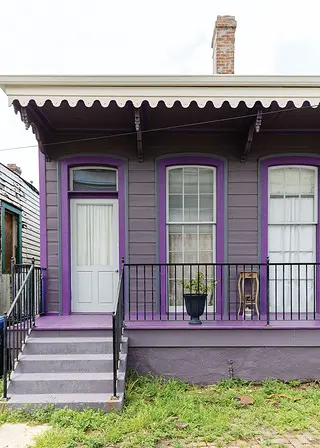
photo by: Cedric Angeles
A Tremé house after the completion of its Revival Grant work.
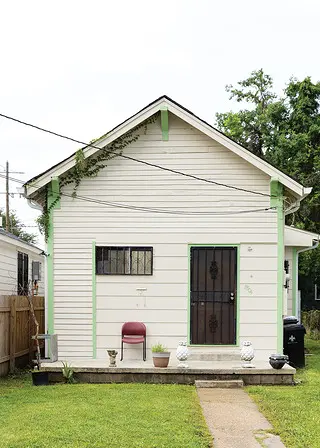
photo by: Cedric Angeles
Another New Orleans house once its Revival Grant repairs were done.
Shotgun homes have historically been considered affordable, thanks to their efficient layout. When two shotgun units are adjoined side by side to create a duplex, known as a “shotgun double” or “double shotgun,” they even offer the opportunity to rent out one side for extra income.
In the years since Hurricane Katrina, however, affordability has increasingly become a challenge.
“The storm was in 2005, but it was really the recovery afterward that turned the New Orleans economy on its head,” explains Michelle Shoriak, director of conservation and education at the Preservation Resource Center of New Orleans (PRC), a nonprofit with the mission of preserving the city’s historic architecture, neighborhoods, and cultural identity.
High poverty rates and a dearth of affordable housing had been problems in the city long before Katrina. But the storm exacerbated the issue by decimating the housing supply in many neighborhoods. When the recovery effort attracted an influx of young, bright-eyed workers from wealthier parts of the country, many of those newcomers fell in love with the city, its culture, and its lower cost of living.
“They came with great intentions, but they also could pay more for housing than many locals could,” Shoriak says. “They purchased homes in historic neighborhoods, inadvertently pushing out those who had been there for generations and sending the price of homeownership through the roof.”
“Then,” she adds, “the proliferation of short-term rentals made these problems even worse.”
“People think it’s the food, music, and architecture that make New Orleans culture special. But they’re only partially right. What’s really important are the people. Who cooks the food? Who plays the music? Who has lived in these homes for generations?”
Darlene Joseph Jones
As home values rose, so did property taxes and the amount for which a home needed to be insured. More frequent natural disasters and the rising cost of rebuilding also hiked up the cost of insurance.
According to Housing NOLA, a local nonprofit organization working to solve the affordable housing crisis in New Orleans, nearly half of the city’s residents can no longer afford where they live.
Desperate to stay in her house, Darlene Jones searched for grants that would provide financial assistance to make the necessary repairs.
Most of the grantors she found were either out of funding or hesitant to do the sometimes challenging work associated with preservation in historic neighborhoods.
After several misses, she found the Revival Grants program. Her luck began to change.

photo by: Cedric Angeles
Danielle Del Sol, former executive director of the Preservation Resource Center of New Orleans.

photo by: Cedric Angeles
The owner of this home participated in a new grant program that covers historic houses in all the city's neighborhoods.
Launched in 2019 to help homeowners like Jones with the upkeep of their historic houses, the program was the brainchild of Danielle Del Sol, who until recently was executive director of the PRC. To be eligible for a grant, in addition to living in a historic district, qualifying applicants had incomes no higher than 80% of the area median income (AMI).
“We were watching these historic neighborhoods around the French Quarter—they might not have been wealthy, but they had extraordinary cultural wealth—getting absolutely torn apart by this confluence of economic forces,” Del Sol says. “We knew something needed to be done and, as an organization focused on historic preservation, we thought we could help.”
Under Del Sol’s leadership, the PRC got to work—raising funds, vetting applicants, and forming partnerships with quality local contractors able to take on the important work of rehabilitating historic houses. The National Trust’s African American Cultural Heritage Action Fund provided a grant in 2019, after another National Trust grant helped start the program.
“Preservation doesn’t simply refer to a house with its walls and roof. It also means preserving a culture, a community, and family bonds. That is what we hope the program can help to accomplish.”
Danielle Del Sol
Initially, the PRC allotted $5,000 per project, but soon quadrupled the amount to $20,000 when it saw the scope of work that many of the residences required.
Jones was an early applicant. After Hurricane Zeta swept through in 2020, a leaking roof added to the longtime issues she was having at the back of her home. To her immense relief, the PRC worked with a contractor to repair her roof, restack a foundation pier that had been causing problems for more than a decade, and eradicate a growing termite colony discovered mid-project.
“I can’t put into words what PRC means to me,” Jones says. “‘Important’ doesn’t do Revival Grants justice. What is more important than important? Essential? Lifesaving? I wouldn’t be in my home to fight another day without them.”
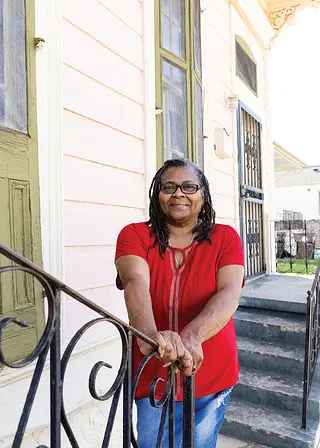
photo by: Cedric Angeles
Paula Harvey, whose house is shown at the top of this story.

photo by: Cedric Angeles
Michelle Shoriak, director of conservation and education at the Preservation Resource Center of New Orleans.
While the rehabilitation of historic houses has been the program’s mandate, Del Sol understands that the effect of the work extends far beyond the physical structure of a dwelling.
“Preservation doesn’t simply refer to a house with its walls and roof,” she explains. “It also means preserving a culture, a community, and family bonds. That is what we hope the program can help to accomplish.”
That has certainly been the case for Paula Harvey, who lives in an Italianate double shotgun house. A Revival Grant helped keep her in the home by covering termite removal and repairs to termite-damaged areas; the repainting of the front facade; and the replacement of the roof and other deteriorated building elements.
“This home was gifted to me by family members when I was pregnant with my second son in 1987,” she says. “All of my most cherished memories took place under this roof.”
Harvey says the Tremé community has also become a family over decades of looking out for one another: watching each other’s children, supplying home-cooked meals when someone gets sick, teaming up to clean out storm drains before hurricanes, driving voters to polling places during elections.
“I know the second-line brass musicians by name, and they know me,” she says. “This is what a community is supposed to be. But it feels like it’s becoming a little different now.”
Slowly, many residents whose families have occupied these homes for more than a century have been forced to move, unable to keep up with rising costs. They often relocate to cities with larger inventories of housing, like Houston and Atlanta. In their place arrive newer residents from far-off cities such as New York, Boston, and Chicago. Or, in many cases, a never-ending carousel of visitors.
“The tourists who stay in their short-term rentals are nice,” Harvey says. “I don’t blame them. Some of them are really interested in the neighborhood and ask questions about ‘the historic Tremé.’ But this is a real place we live in. We want to keep our actual community intact.”
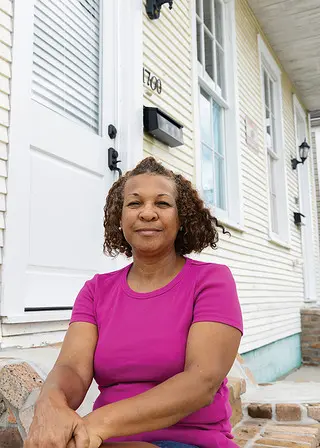
photo by: Cedric Angeles
Denise Tate, who received a Revival Grant in 2024, had already made other repairs.
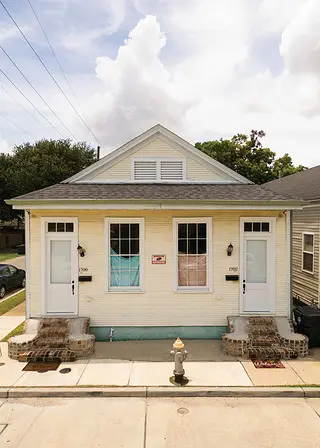
photo by: Cedric Angeles
Tate’s shotgun double in Bywater, after Revival Grant–funded repair and restoration work.
As of July 2025, the PRC had completed 20 Revival Grant rehabilitations, with several more mid-project. The organization’s leaders have worked hard to expand the program from its initial $100,000 budget.
In fact, this year the city of New Orleans invested $250,000 to create a second PRC program that expands the scope to houses 50 years old or more in all the city’s neighborhoods, rather than just its historic districts. (Two projects have already been completed under this second program.) Similarly, the Jazz and Heritage Foundation has donated $100,000 to the PRC to launch a third program, aimed at providing assistance to “culture bearers”—people deeply rooted in their communities through work in music, storytelling, dance, art, and more.
This year, the three programs have the capacity to complete a total of 15 projects—up from five previously. And in 2026, with support from Travelers through the Travelers Across America initiative (a joint initiative between the National Trust for Historic Preservation and Travelers Insurance), PRC will channel additional grant funding through its acclaimed Revival Grants Program to deliver critical repairs—such as fortified roofs, improved drainage, and window restoration—that strengthen homes against hurricanes and flooding.
“If our goal is to preserve culture and community,” Shoriak says, “then working with culture bearers makes a lot of sense. Keeping them in their homes is essential because New Orleans wouldn’t be New Orleans without them.”
Many Revival Grant applicants discover the program after being threatened with fines for violations by the city’s Historic District Landmarks Commission (HDLC).
“Now, when I come home from my job, I look at this beautiful porch and these gorgeous windows and I say, ‘I can’t believe I get to live here! How lucky am I?”
Denise Tate
This was the case with Denise Tate, the 60-year-old owner of a shotgun double in the historic Bywater neighborhood. She purchased the house in 2013 with money she saved working two jobs as a bus driver.
What Tate didn’t realize was that the home came with a handful of costly historic district violations, inherited from the previous owner. These included a visible satellite dish; inappropriate roof work, front doors, and windows; missing transoms; and missing gable-end windows. Tate set aside earnings from her jobs and completed much of the work, but after funeral costs related to her brother’s unexpected death, the loss of rental income because of hurricane damage on the other side of her shotgun double, and her monthly insurance payments rising to $500, she was out of money.
“It felt like every time I took a step forward in life, it was followed by three steps backward,” she says. “This was tens of thousands of dollars of work that the HDLC was demanding I do. I was fighting to keep my home, but it felt like I was out of options.”
That is when, in 2023, Tate learned about the Revival Grants program.
Working with a local construction company, the PRC resolved each of the remaining violations. It replaced the broken steps on her front porch and replicated her old windows and nearly 10-foot-tall doors. The PRC also has an agreement with the city that all of a resident’s outstanding HDLC violations are forgiven once the work is complete.
“It makes me want to cry, if I’m being honest with you,” Tate says. “I was an inch from losing my house. But now, when I come home from my job, I look at this beautiful porch and these gorgeous windows and I say, ‘I can’t believe I get to live here! How lucky am I?’”
It was exactly what Del Sol imagined when she dreamt up the initiative, which has been so successful that several other cities have shown interest in replicating the program.
Del Sol says what surprised her most about the work—and what motivated her—was that the large majority of applicants are over 60.
“It has been the most rewarding piece of the program,” she acknowledges. “These New Orleanians have been working their entire lives to have something they can pass to their families, all to have that dream put at risk in their later years. That we can relieve them of this fear and anxiety all while keeping communities whole—that is a real honor and, I think, really important work.”
Donate Today to Help Save the Places Where Our History Happened.
Donate to the National Trust for Historic Preservation today and you'll help preserve places that tell our stories, reflect our culture, and shape our shared American experience.


